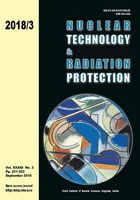
RADON REMEDIATION EFFICIENCY ASSESSMENT IN THE KIROVOGRAD REGION, UKRAINE

Vol.
XXXIII, No. 3, Pp. 231-323
September 2018
UDC 621.039+614.876:504.06
ISSN 1451-3994
Pages: 317-323
Authors: Tetiana Pavlenko, Olga German, Nikolay Aksenov, Miroslava Fryzyuk,
and Anatoliy OperchukAbstract
This article provides a review of radon remediation methods and an algorithm of their applications. The methods assessed are applicable for indoor radon originating from the ground beneath or around a building. It was established that radon activity concentration in underlying soil or ground ranging between 15 and 30 kBqm-3 would contribute to an average annual indoor radon concentration from 20 Bqm-3 reaching up to 1030 Bqm-3 in the region, i. e., a 10-15 fold difference, while the average radium concentration in soil was assessed as 30 Bqkg-1. The geo-morphological analysis in the investigated region classifies the top soil as very permeable, containing huge volumes of soil air which is easily transported with the temperature and pressure gradient. It was demonstrated that both soil characteristics and construction characteristics must be taken into account when designing radon remediation methods.
One hundred eighty nine buildings were investigated, remediated, and assessed as part of this research work. The average remediation efficiency was established as 50 %. The paper provides an overview of recommended remedial actions and most common mistakes made by construction experts influencing the efficiency of radon remediation.
Key words: radon, remediation, efficiency
FULL PAPER IN PDF FORMAT (342 KB)